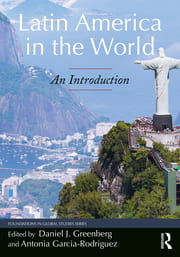Dyson Seminar in the Humanities & Social Sciences
Faculty Book Presentation:
Latin America in the World: An Introduction (Routledge, 2020)
by Garcia-Rodriguez and Daniel J. Greenberg (eds.)
Monday, March 8, 2021, at 12:10–1:10PM via Zoom
Speakers:
Antonia Garcia-Rodriguez & Daniel Greenberg
Antonia Garcia-Rodriguez is a professor of Spanish and French in the Department of Modern Languages & Cultures in New York. She has served as chair and bi-campus chair (NY and PLV) of the department and is co-creator of the Latin American Studies program at Pace University. Her publications include articles on gender, race, ethnicity, class, transnational identity, and mother/daughter relationships in the texts of women writers of Latin America, especially the Caribbean and Latinx writers. She is active in several scholarly organizations, especially the National Association of Hispanic and Latino Studies.
Daniel Greenberg is Professor of History and Director of Pace’s Latin American Studies Program. With Antonia Garcia-Rodriguez, he is author and co-editor of Latin America in the World, An Introduction (Routledge, 2020). He also contributed two chapters to Antonio Pedro Tota’s The Seduction of Brazil: The Americanization of Brazil during World War II (Texas, 2009), and published articles on the social and economic history of modern Argentina, comparative history of social revolution, the social impact of economic globalization, and foreign relations of Argentina and Brazil. In 2004, he won a federal Department of Education grant to strengthen the LAS program.
____________________________________________________________
Garcia-Rodriques and Daniel J. Greenberg (eds.), America in the World: An Introduction (Routledge, 2020)
Abstract
This text offers students and researchers a fresh, comprehensive, multidisciplinary entry point to Latin America. After a brief introduction to the study of the region, the early chapters of the book survey the essentials of Latin American history; important historical narratives; and the region’s languages, religions, and global connections. The second half of the book features interdisciplinary case studies, each of which focuses on a specific country or subregion and a particular issue. Each chapter gives a flavor for the cultural distinctiveness of a particular country yet also draws attention to global linkages. Readers will come away from this book with an understanding of the larger historical, political, and cultural frameworks that shaped Latin America as we know it today, and of current issues that have relevance in Latin America and beyond.

